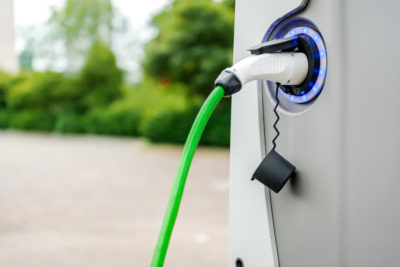
By Al Bredenberg
If your dealership is selling electric vehicles (EVs), you most likely already have a charging station in your service area. However, could publicly-available charging stations find a place at the dealership as a way to expand revenue, to bring in more traffic to the business, or to deepen engagement with customers?
By and large, dealerships in the U.S. market still have limited expertise with selling EVs. But that could change radically over the next few years, as automakers roll out new electric models, and as EV adoption increases. Bloomberg New Energy Finance projects that, while China will continue to dominate the market in EV adoption, yearly electric vehicle sales in the U.S. will reach about 5 percent of the market by 2023, and about 60 percent by 2040.
To some degree, the rollout of public EV charging stations needs to take place ahead of EV purchasing, to decrease range anxiety and motivate more EV sales. Dealer News Today spoke recently with Darryll Harrison, senior director of communications for ChargePoint, which provides EV charging stations and associated network technologies. Harrison told us, “ChargePoint tends to grow about 15 to 20 percent ahead of EV sales in the market.”
With increased market adoption, key players gain motivation to help deploy the needed charging infrastructure — including OEMs, dealerships, and electric utilities. Government incentives and grants can spur deployment as well.
How EV Charging Works
In the U.S., the EV charging infrastructure is divided generally between the rapidly-growing open-standard network, and Tesla’s proprietary charging technology. The U.S. Department of Energy (DoE) identifies three primary classes of electric vehicle supply equipment (EVSE), or charging stations:
- AC Level 1 Charging (L1): Charging via a standard 120-volt AC plug, providing two to five miles of range per one hour of charging. L1 is used almost exclusively in EV owners’ homes.
- AC Level 2 Charging (L2): Charging via 240-volt (common in residential) or 208-volt (common in commercial) electrical service. Level 2 is common in home charging, as well as in public charging, and can provide 10 to 20 miles of range per hour of charging.
- DC Fast Charging (a.k.a. DC Level 2): This equipment class is used particularly along heavy traffic corridors, and can provide 60 to 80 minutes of range per 20 minutes of charging.
DoE says more advanced standards are under development as well.
Wanted: 601,000 Public Level-2 plugs, 27,500 Fast-Chargers
The projected need for public charging stations does point to an opportunity for auto dealerships to participate. The DoE’s charging location map identifies a little over 23,000 charging locations in the U.S., as of November 2019, counting both Level 2 and DC fast charging equipment, and including Tesla locations.
According to a report from research firm Frost & Sullivan, by far the greater number of public charging stations are located at places like hotels, shopping centers, stores, workplaces, and parking garages. Only about 4 percent of stations are currently at automobile dealerships.
The Department of Energy’s National Plug-In Electric Vehicle Infrastructure Analysis attempts to describe the charging infrastructure that will be required in the U.S. to support EV market adoption between now and 2030.
Not to make a prediction but just for the purposes of its study, the agency assumes plug-in electric cars will make up about 20 percent of U.S. light-duty vehicles (LDVs) by 2030. DoE estimates that, for each 1,000 EVs on the road, the U.S. needs an average of 6.8 DC fast-charging plugs and 169 non-residential Level-2 plugs. Some of these plugs need to be in cities, some in towns, and some in rural areas; some of the fast-chargers need to be on Interstate corridors.
The upshot is that, to meet the demands of the study’s central scenario, the U.S. would need 601,000 non-residential public Level-2 plugs and 27,500 DC fast-charging plugs. DoE supposes that the fast-charging plugs could be provided at 8,500 multi-plug stations. Some fast-charging equipment will be required along Interstate corridors, but most infrastructure will be needed in towns and cities.
The report comments:
“About 4,900 DCFC stations are required across cities, with an additional 3,200 DCFC stations required in towns to provide a minimum level of nationwide coverage in the communities where 81 percent of people live. Such a network would dampen range anxiety concerns by providing drivers with a safety net for emergency charging situations.”

EV Chargers: Siting and Cost Considerations
From Gas to Grid, a report from Rocky Mountain Institute (RMI), considers how to make decisions about siting and installing charging equipment. When deciding which type of charger to install at a given location (Level 2 versus DCFC), RMI suggests asking the following questions (quoting from their report):
- What kinds of vehicles are likely to visit the charger now and in the future?
- How depleted are the vehicles’ batteries likely to be when they arrive, and how much of a charge will they need?
- How long is the vehicle likely to remain connected to the charger?
- What is the cost of providing charging service at that location?
- Who owns the charger and what is his or her business purpose for hosting or owning it?
For the auto dealership thinking about installing public charging equipment, one of the biggest challenges will be optimizing cost of installation versus utilization patterns. Level 2 charging equipment is much more affordable than DCFC, but takes longer to charge a vehicle. The regional electric utility could be a help in making decisions about what to do, and should be consulted in any case, given the potential effect on the electric grid.
“You will almost never see a dealership application where all of the chargers are DC because the cost, energy needed, and so on make it prohibitive,” said Erin Lumley, a spokesperson for ChargePoint, replying to our questions about typical dealership installations. A mix of equipment is likely a better choice for most businesses, she said: “For many dealerships, we have seen a combination of charging, both L2 and DC: L2 for charging that doesn’t require a quick top up and DC for the few times a quick charge is required.”
ChargePoint offers charging equipment and services for auto dealerships, including both public and service-bay charging. Its services include cloud-based networking to control charging settings and operations, along with visibility and reservations capability through a mobile app deployed to EV users.
A networked solution can give the station owner significant flexibility in terms of pricing and hours of operation. “A dealer can decide to control access to charging,” said Lumley, “making charging available during business hours to the public and unavailable after hours or vice versa. They can also decide which chargers are private and which are public among the chargers they manage. Again, charging is flexible and can be deployed and adapted based on the application.”
Taking a Holistic View: “It’s Not Just About the Chargers”
Just based on the revenues from charging stations, you might be hard-pressed to see the business benefits. To bring in enough revenue to recover the cost of equipment installation might require a buildup of customer traffic over a longer period of time.
However, the more likely business rationale centers around new opportunities for customer engagement. Obviously, EV charging can get the consumer into the showroom, with a half-hour, an hour, or more to kill. But the value could go beyond simply the opportunity for another sale.
For some businesses, an EV charging center might make more sense as an element of an open-design facility where a customer won’t mind hanging out for an hour while the car charges. Most dealerships now have customer lounges with coffee, TV, and wifi, but some have decided to make their businesses even more welcoming by adding features like business centers, cafes, or restaurants.
- Marcotte Ford in Holyoke, Mass., recently opened a co-located LugNutz Cafe, serving breakfast and lunch.
- Swope Toyota in Elizabethtown, Kentucky, hosts a cafe and deli that offers views of nearby Freeman Lake.
- When someone buys a vehicle at Jaguar Merritt Island in Florida, the customer is automatically enrolled in the dealership’s Island Club, which includes access to a business center, arcade, fitness center, and barber shop. The dealership also has a co-located Island Tiki Grill, which serves breakfast and lunch.
This is just to point out that many owners are turning their dealerships into more than just places that sell and fix cars. As electric vehicles gain more market penetration, charging services could become part of an expanded view of what an automobile retail location can be.
“One thing that’s important to put in context is that fueling behavior when you’re driving an electric vehicle is very different from a gas car,” said ChargePoint’s Darryll Harrison. “Fueling behavior with EVs is more similar to the way you charge your mobile device, so charging can be deployed in far more places than gas stations. People tend to charge their cars where they’re going to be doing something else anyway.
“Typically we see auto dealerships deploying charging, not necessarily to generate revenues,” Harrison said, “but because they want to drive traffic by offering an amenity for customers, employees, or the public. As more automakers introduce electric models, charging is going to become an essential service. Charging will help attract drivers into the showroom and give dealers an opportunity to educate consumers and engage with them in ways they never have before.” Harrison points out that even gas stations don’t really make that much money by selling gas. But by marrying fuel sales with a convenience store or fast-food operation, owners have been able to make a business out of it. “You have to look at charging in a more holistic way,” he stressed. “It’s not just about the chargers.”












